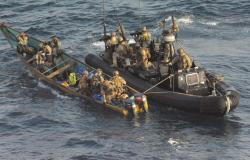
In view of continued international counter‐piracy efforts and these recent incidents, this article takes the five obstacles presented by Percy and Shortland (2013), as its point of departure for an analysis of key developments of importance for Somali piracy since 2013. Specifically, the article firsts offer an analysis and updated version of Percy and Shortland's five obstacles. Second, I argue, that a sixth obstacle should be added. This obstacle is the phenomenon that practitioners as well as academics working with organised crime refer to as ‘poly‐criminals’. Having elaborated on this additional obstacle – with reference to interviews conducted with key actors in Somalia – the third section explicates the policy impact of poly‐criminal pirates; it offers a discussion of what this alternative conception means for external actors’ counter‐piracy engagements, with particular attention to the risk of creating ‘balloon effects’ when addressing a challenge of this kind (poly‐criminals) through too narrowly defined counter‐piracy lenses, mandates and programmes.
Policy Implications
- Continued focus on on‐shore challenges is necessary despite the fact that levels of Somali piracy are historically low.
- Continue corruption and impunity points to need for more concerted international donor pressure in current counter‐piracy efforts.
- A key implication of understanding Somali pirates as poly‐criminals is that the risk of pirates shifting to another type of criminal business as a result of narrowly defined counter‐piracy mandates and programmes become visible – which in turn should have implications for future counter‐piracy/counter‐maritime crime engagement.
- Describing the current balancing act of industry eager to ease the expensive security measures being advised by best management practices and industry releasable threat assessments and the risk of ‘lowering the bar too far’ also has implications for how to think about the future of industry involvement in counter‐piracy off the Horn of Africa.